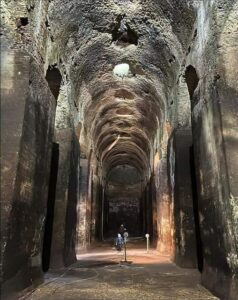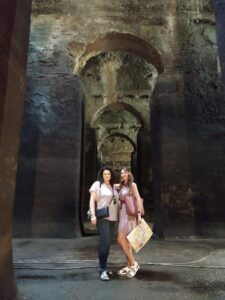The Cisternone water reservoir is one of the most significant historical structures from the Roman Empire, hidden deep underground in Albano Laziale, near Rome, Italy. This structure is not only a testament to the skill and ingenuity of ancient Roman architects but also demonstrates the remarkable durability of their construction techniques. Let’s explore the fascinating details of the Cisternone and understand why it remains functional even after nearly 2,000 years.
History and Origins of the Cisternone Water Reservoir
The Cisternone was constructed between the 2nd and 3rd centuries AD, during the reign of Emperor Septimius Severus. Its original purpose was to supply water to the military camp of the Second Parthian Legion. This was a period when the Roman Empire was expanding its territory, and a stable water supply was essential for the soldiers stationed in the area.
With an impressive capacity of up to 10,000 cubic meters, or around 2.64 million gallons of water, the Cisternone reflects the importance of water resource management in both military and civil Roman systems. This reveals the meticulous planning and foresight of Roman leaders of the time.

Unique Design and Construction Techniques
One of the most remarkable aspects of the Cisternone is its unique architectural design. The structure has an irregular quadrilateral shape, measuring about 30 meters wide and 50 meters long. The reservoir is divided into five naves by 36 sturdy pillars, which support and segment the internal space.
The Cisternone combines rock excavation and brick construction, which were characteristic techniques of ancient Roman engineering. The interior walls are coated with a waterproof layer of plaster, designed to protect the reservoir from water erosion. This waterproofing is one of the reasons why the structure has endured for centuries with minimal damage.

Continuous Functionality Through the Centuries
The most extraordinary feature of the Cisternone is not just its size or design, but its uninterrupted functionality. Despite nearly 2,000 years of history, the channels delivering water from the springs around Lake Albano are still operational and continue to supply water to this ancient structure.
The Cisternone’s water supply system showcases the advanced engineering skills of the Romans in building water distribution networks. It also demonstrates their detailed calculations and ability to adapt the structure to the surrounding landscape. After millennia, the system still functions smoothly, serving not only soldiers but also fulfilling the clean water needs of the local residents.
Cultural Importance and Historical Significance of the Cisternone
The Cisternone was not merely a military utility; it also carries significant cultural and social value. Over the centuries, it has become a gathering point for the community of Albano Laziale, providing clean water to the local population. In ancient times, a stable water source was seen as essential for settlement and societal development, and the Cisternone’s existence exemplifies the strategic foresight of the Romans.
Today, the Cisternone remains operational and serves as a major tourist attraction, drawing those passionate about ancient history and architecture. This structure reflects the Romans’ meticulous attention to detail, as well as the influence of Roman civilization on modern culture and engineering.

Technical Analysis and Lessons for Modern Architecture
The Cisternone offers valuable lessons on construction techniques and resource management. The waterproof plaster layer, intelligent water distribution system, and sustainable design have all contributed to its longevity. Today’s designers and architects can learn from the durability of ancient Roman structures, especially regarding environmental conservation and resource efficiency.
Furthermore, the adaptability of the Cisternone to its surroundings, despite geological and climatic changes over the centuries, reflects the Romans’ sustainable thinking. The Cisternone exemplifies how a well-constructed, thoughtfully designed structure can withstand time and continue to serve for centuries.
Conclusion
The Cisternone water reservoir is not only a symbol of Roman technical prowess but also a precious cultural heritage, linking past and present. From supplying water to Roman soldiers to becoming a historical landmark, the Cisternone has traveled a long journey and has retained its intrinsic value. It stands as powerful evidence of the greatness of the Roman Empire and as a lesson in sustainable construction, enduring across the ages.
